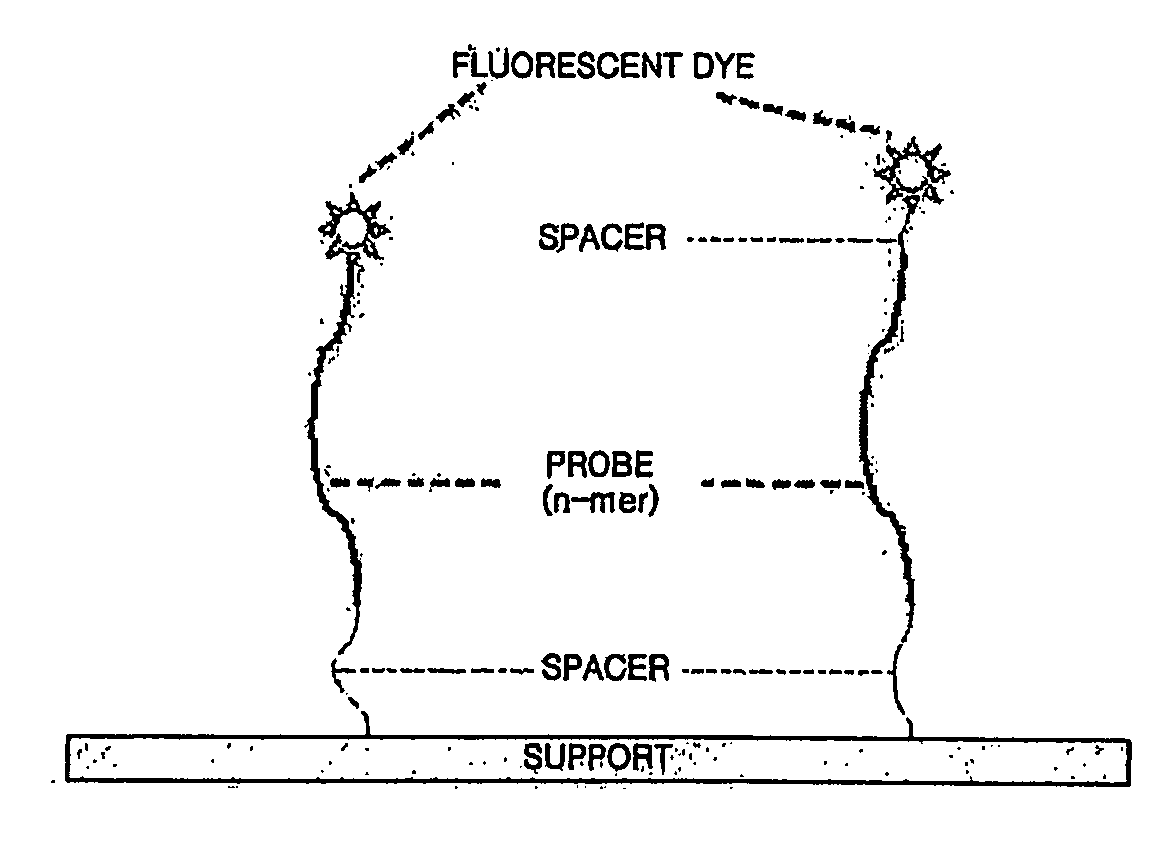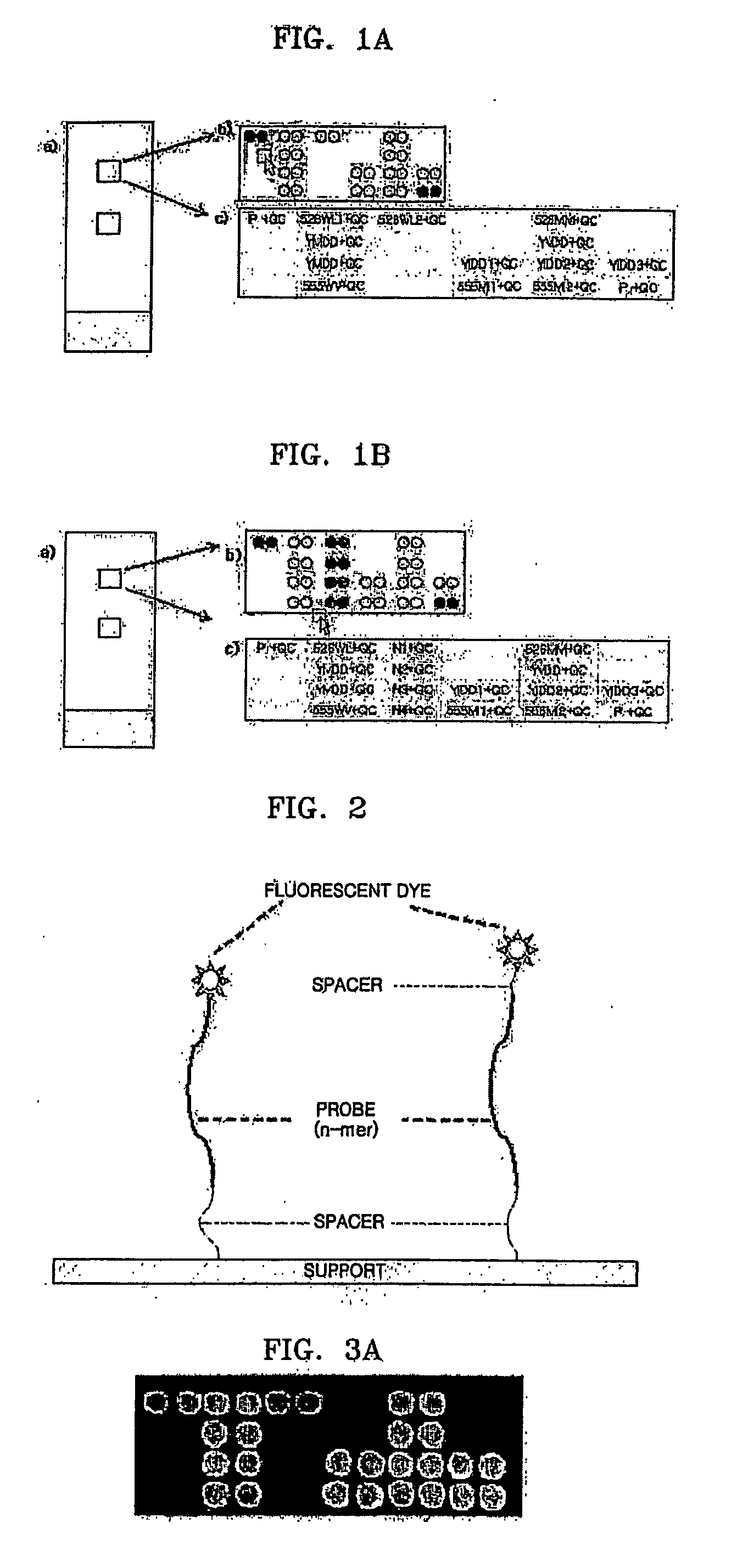Microarray comprising probes for drug-resistant hepatitis b virus detection, quality control and negative control, and method for detecting drug-resistant hepatitis b virus using the same
a technology a microarray is applied in the field of microarrays for detecting a drug-resistant hepatitis b virus, which can solve the problems of drug resistance, side effects, recurrence after treatment, cost ineffectiveness, etc., and achieves the effects of reducing diagnosis time and cost, high sensitivity, and accurate control
- Summary
- Abstract
- Description
- Claims
- Application Information
AI Technical Summary
Benefits of technology
Problems solved by technology
Method used
Image
Examples
embodiments
EXAMPLE 1
HBV DNA Isolation
[0059] A blood sample taken from a HBV carrier was stored in a refrigerator for 1 hour for coagulation and subjected to centrifugation at 3000 rpm for 5 minutes to separate serum. The separated serum was stored at −70° C., and 200 μL of HBV DNA was extracted from the serum using a QIAmp DNA Blood Mini Kit (QIAGEN Inc., CA, USA) and used as a template DNA for polymerase chain reaction (PCR).
example 2
HBV Detection and Preparation of Target Probes for Drug-Resistant HBV Detection
[0060] Oligonucleotide probes and primers used in the present invention were prepared by synthesizing probes each including 15-25 nucleotides with a dT spacer of a length of C6-15 at 5′-terminal (5′-Amino-Modifier C6-15) using a Perkin Elmer DNA synthesizer (USA) and isolating by PAGE. The prepared target probes and primers are listed in Table 1 below.
[0061] In Table 1, SEQ ID NOs. 1 through 6 are forward and reverse primers for HBV DNA polymerase gene, SEQ ID NOs. 1 and 2 are outer primers for primary PCR, and SEQ ID NOs. 3 through 6 are biotin-labeled inner primers. SEQ ID NOs. 7 through 14 are probes for lamivudine detection, SEQ ID NOs. 7 and 8 are probes for detecting a wild type at codon 514, and SEQ ID NOs. 9 through 14 are probes for detecting a mutant at codon 514. SEQ ID NOs. 15 through 25 and NOs. 45 through 47 are probes for detecting lamivudine and famciclovir, SEQ ID NOs. 15 and 16 are pro...
example 3
Preparation of Fluorescent Dye-Labeled QC Probes
[0062] A fluorescent material having an emission wavelength different from a fluorescent material used for target probes is selected to label QC probes. For example, when Cy5 is used with an emission filter for 670 nm to detect the binding of target products and target probes on an oligonucleotide chip, Cy3 or TAMRA, which have emission wavelengths near 570 nm, can be used when synthesizing QC probes. When both Cy3 and Cy5 are used to label target probes on a cDNA chip, a fluorescent material having a different emission wavelength from Cy3 and Cy5 is used when synthesizing QC probes.
[0063] In the present invention, the fluorescent material used to label QC probes includes, but is not limited to, at least one of materials listed in Table 2 that have different emission wavelengths from a fluorescent material used to label target products.
TABLE 2Fluorescent materials that can be used in microarray for QCExcitationEmissionEmissionFluor...
PUM
| Property | Measurement | Unit |
|---|---|---|
| emission wavelengths | aaaaa | aaaaa |
| emission wavelengths | aaaaa | aaaaa |
| temperature | aaaaa | aaaaa |
Abstract
Description
Claims
Application Information
 Login to View More
Login to View More - R&D
- Intellectual Property
- Life Sciences
- Materials
- Tech Scout
- Unparalleled Data Quality
- Higher Quality Content
- 60% Fewer Hallucinations
Browse by: Latest US Patents, China's latest patents, Technical Efficacy Thesaurus, Application Domain, Technology Topic, Popular Technical Reports.
© 2025 PatSnap. All rights reserved.Legal|Privacy policy|Modern Slavery Act Transparency Statement|Sitemap|About US| Contact US: help@patsnap.com



